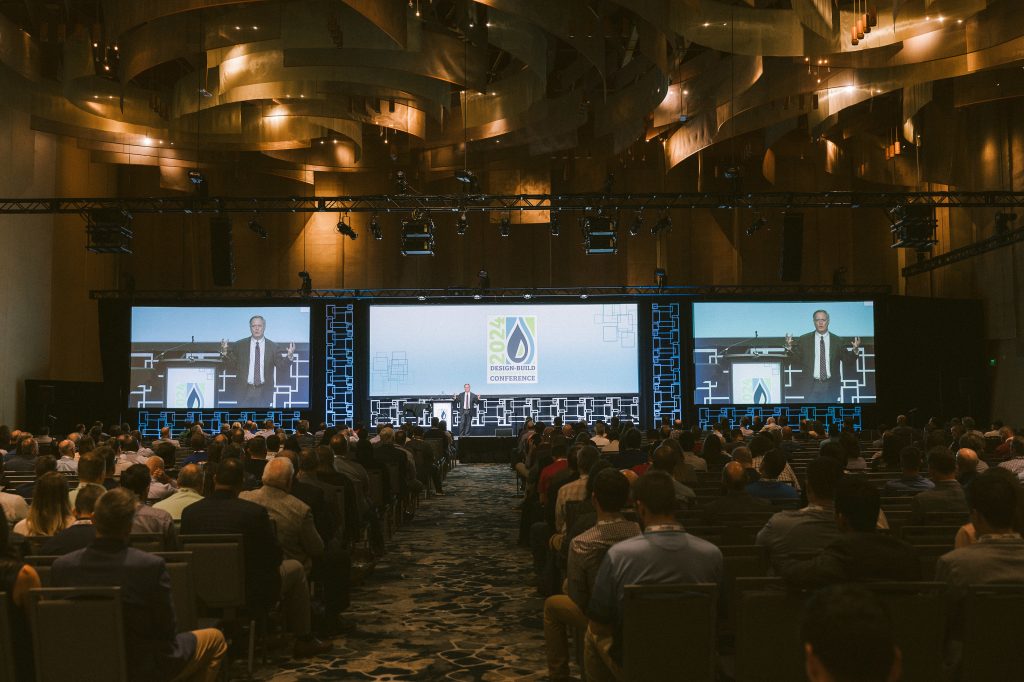
Photo by Robb McCormick Photography (robbmccormick.com)
Over the past three days, DBIA has been in Cincinnati, Ohio, for the Design-Build for Water/Wastewater Conference. This year’s event was an attendance record-breaker, with nearly 1,400 AEC professionals from throughout the industry and across the United States coming together at the Duke Energy Convention Center.
The conference featured inspiring General Sessions and four tracks of education on hot button issues and trends in design-build, including a session focused on the development of updated Best Practices for the Water/Wastewater sector. Tracks focused on unique challenges, readiness through holistic thinking, navigating gray areas and unforeseeable issues, and managing project budgets and financing. Throughout the event, conference-goers enjoyed a number of networking opportunities in the Exhibit Hall, where they connected with organizations and firms that can help further optimize design-build projects in the water and wastewater sector.
Kicking it Off With a Splash

The event began with a keynote address by Robert Bilott, the environmental lawyer who inspired the film Dark Waters. Bilott shared his 20-year legal battle against DuPont, exposing massive chemical contamination. His story is a legal drama of perseverance against environmental regulation failings, uncovering one of the greatest human health crises of the 21st century. DBIA spoke to National Board of Directors Chair Dana Pomeroy, AIA, LEED AP, DBIA, about the buzz Bilott’s talk created among attendees.
“Robert really had a story that touched everyone’s lives,” Pomeroy said. “I looked around the audience, and I did not see any cell phones out –– and that’s rare. His passion to make sure we as a human race are protected and people are held accountable for what they’re doing to the environment was truly very worthwhile.”
Following the Opening Keynote, individual Owners’ and Practitioners’ Forums provided an opportunity for both groups to share their tips, challenges and opportunities with others in similar roles on design-build teams.

Calming Troubled Waters: Best Practices, Case Studies and Complex Issues
Tuesday featured a full day of programming, beginning with a General Session exploring the updates to the Best Practices for Water/Wastewater, set for release in the coming months. Design-build in the water/wastewater market sector saw significant growth and evolution, necessitating the revision to DBIA’s Best Practices for the sector. The session explored updates tailored for this sector, led by a team of experts, to address its unique intricacies and requirements and building on the updated Universal Best Practices introduced in 2023.

After the General Session, attendees chose from each of the four tracks to develop their design-build knowledge in practical ways. Some of the sessions featured case studies, like a look at a Wilmington (Ohio) wastewater treatment plant, the replacement of the City of Wichita’s 80-year-old water treatment plant and a new state-of-the-art 50 million gallons per day clean water center in Fort Lauderdale. Others focused on process, research and other larger-scale information to help design-builders succeed. Topics covered in these sessions included design management in water/wastewater, becoming an Owner of choice, contracting and pricing in progressive design-build, and techniques for navigating labor challenges in the industry.
Newly-certified Associate DBIA professional Atilana Bolton, Assoc. DBIA, of Structural Technologies felt particularly motivated by Using Design-Build to Navigate Professional and Craft Labor Volatility, a Tuesday afternoon session from the track titled Head-Scratchers: Complex Issues Meet Design-Build. “They’re talking about the new generation that’s coming up and ways to attract and keep the younger generation,” Bolton said, adding, “that really stuck with me because I am that generation. Getting to know there are others thinking about my future and how they can help me develop and keep growing was nice to see.”
A Rising Tide Floats All Projects: Progressive Design-Build Helps Design-Build Grow
Attendees concluded the Water/Wastewater Conference by joining the incoming group of Transportation/Aviation attendees at a joint lunch and General Session on progressive design-build (PDB). The growth of design-build can be attributed in part to its flexibility, but the emergence of PDB has been another significant factor. Over the past two years, interest in PDB has surged as Owners and design-build teams turn to PDB to mitigate cost and schedule risks amid larger, more complex infrastructure projects. Many states have recently begun allowing PDB or enacting legislation to address it. Because of the increasing interest in PDB, it was a logical choice for a joint session.
Ryan Cummings, EIT, of Nicholson Construction reflected on the PDB session. “The session was just an incredible way to think about what the different groups are doing in progressive design-build and what values we as subcontractors can add to that earlier in the process.”

Design-Build Leaders Set Sail on Collaborative Delivery Leadership Voyage
DBIA’s week in Cincinnati also featured a session of the Collaborative Delivery Leadership Academy on the Sunday before the conference. Roughly 20 attendees completed the first course of the six-course Academy, where Dr. Barbara Jackson, FDBIA, introduced foundational steps to understanding and adapting their own leadership styles to be successful in collaborative project delivery.
Missed out on the 2024 Design-Build for Water/Wastewater Conference? Don’t worry! Be on the lookout for select sessions that will be available for purchase in DBIA’s Learning Center in the coming weeks.
Learn more about the Collaborative Delivery Leadership Academy.

